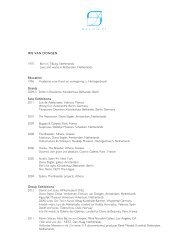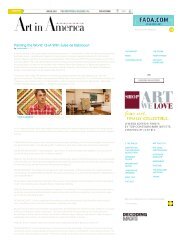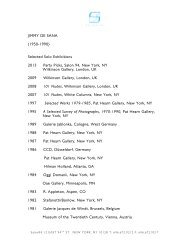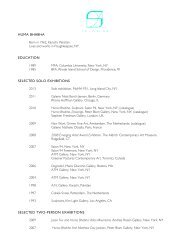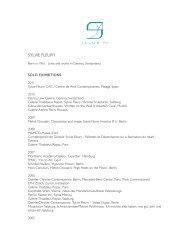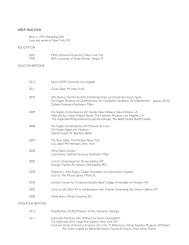Lorna Simpson: Ink at Salon 94 and Salon 94 Freemans By Merve ...
Lorna Simpson: Ink at Salon 94 and Salon 94 Freemans By Merve ...
Lorna Simpson: Ink at Salon 94 and Salon 94 Freemans By Merve ...
Create successful ePaper yourself
Turn your PDF publications into a flip-book with our unique Google optimized e-Paper software.
<strong>Lorna</strong> <strong>Simpson</strong>’s two-part exhibition <strong>at</strong> <strong>Salon</strong> <strong>94</strong> <strong>and</strong> <strong>Salon</strong> <strong>94</strong> Freeman has a quiet tone. The<br />
content of her art is somber. She deals with such issues as gender, identity, war, <strong>and</strong> torture. All of<br />
these subjects are explored by <strong>Simpson</strong> with a formal sophistic<strong>at</strong>ion th<strong>at</strong> gener<strong>at</strong>es provoc<strong>at</strong>ive yet<br />
ambiguous works.<br />
In the uptown space, two bodies of work are exhibited, Photo Booth (2008) <strong>and</strong> Heads (2008).<br />
<strong>Simpson</strong>’s drawings of the backs <strong>and</strong> sides of women’s heads put a special emphasis on hairstyles.<br />
<strong>Simpson</strong> transforms hair into abstract forms. These are not simply represent<strong>at</strong>ions of specific<br />
“heads”. They are multiplicities containing poetic signifiers th<strong>at</strong> go beyond the visible world. They<br />
are reminiscent of Rorschach tests <strong>and</strong> yet they never become non-descript inkblots th<strong>at</strong> are open<br />
to any interpret<strong>at</strong>ion. The drawings are based on photographic imagery <strong>and</strong> by interpreting these<br />
found images through the drawing process, <strong>Simpson</strong> discovers new forms <strong>and</strong> ideas th<strong>at</strong> are not<br />
contained in the original m<strong>at</strong>erial<br />
The h<strong>and</strong> of the artist plays a very different role in Photo Booth (2008). These images are of black<br />
males from the 1<strong>94</strong>0s. The intim<strong>at</strong>e images are reminiscent of Carrie Mae Weems’ work, but<br />
instead of cre<strong>at</strong>ing narr<strong>at</strong>ives, <strong>Simpson</strong> juxtaposes these images to form a cloud-like shape on the<br />
wall. This shape takes on a life of its own <strong>and</strong> an element of abstraction <strong>and</strong> ambiguity is<br />
introduced within a context th<strong>at</strong> in <strong>and</strong> of itself only has historical value. The overall form cre<strong>at</strong>ed<br />
by the accumul<strong>at</strong>ion of individual photographs appears to be more important than the individual<br />
images <strong>and</strong> <strong>Simpson</strong> reiter<strong>at</strong>es this notion by interweaving inkblots among the photographs. The<br />
inkblots become weird surrog<strong>at</strong>es for the photographs, filling gaps to complete a “big” picture. The<br />
artist becomes a medi<strong>at</strong>or of found images <strong>and</strong> the marks she makes. The viewer is responsible for<br />
interpreting this tapestry consisting of personal images of men who are self-consciously posing for<br />
snapshots.<br />
<strong>Lorna</strong> <strong>Simpson</strong> Long, Slow, War (Still) 2008. 2-channel video projection, dimensions variable



